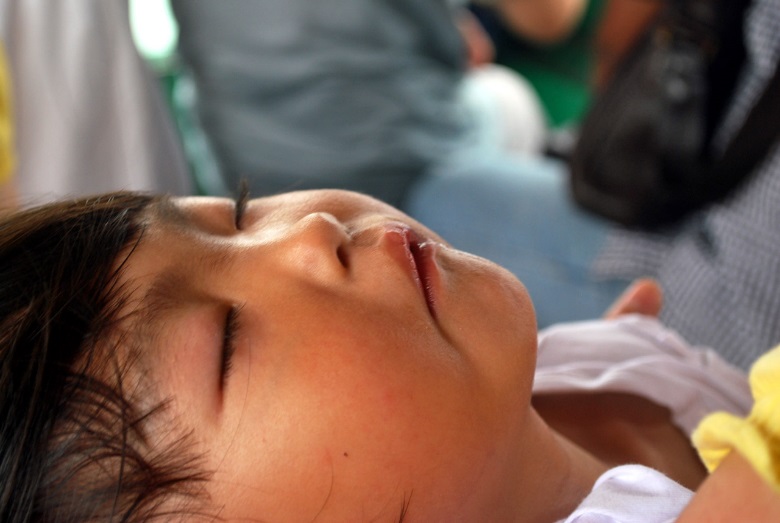The American Academy of Sleep Medicine (2021) has recommended that toddlers get 11 to 14 hours of sleep in a 24 hour period. This may include naps throughout the day. Preschool children will naturally need fewer naps and will typically forgo naps by elementary school. This age group should sleep 10 to 13 hours per day. Children aged 6–12 years should regularly sleep 9 to 12 hours per 24 hours.
Children who do not get enough sleep have a higher risk of obesity, diabetes, injuries, poor mental health, and problems with attention and behavior. Children who get the recommended hours of sleep on a regular basis tend to experience improved attention, behavior, learning, memory, emotional regulation, quality of life, and mental and physical health (American Academy of Sleep Medicine, 2021).

A child sleeping. [Image by Peter Griffin is in the public domain]
Sleep Hygiene
Good sleep habits (sometimes referred to as “sleep hygiene”) can help you get a good night’s sleep. This means having both a bedroom environment and daily routines that promote consistent, uninterrupted sleep.
Some habits that can improve sleep health:
- Be consistent. Go to bed at the same time each night and get up at the same time each morning, including on the weekends.
- Bedtime routines can signal to the body and brain that it is time to sleep. For children, this might include a bath, story, or songs before going to bed. Additionally, limit children’s time spent awake in bed doing non-sleep activities to avoid associating bed with play.
- Make sure the bedroom is quiet, dark, relaxing, and at a comfortable temperature, and avoid allowing children to fall asleep somewhere other than their bed.
- Remove electronic devices, such as TVs, computers, and smartphones, from the bedroom and avoid artificial light for an hour before bed.
- Avoid large meals and liquids two hours before bedtime.
- Get some exercise. Being physically active during the day can help you fall asleep more easily at night.
Sleep Disturbances
Sometimes children have difficulty falling or staying asleep. Changes in routine, excitement, biological changes, health issues, or sleep disorders can be the culprit.
Here are a few suggestions to help children that are having sleep difficulties:
- Use relaxation techniques, such as deep breathing or imagining positive scenes, to help your child relax before bed.
- For children who worry a lot at bedtime, try scheduling a “worry time” earlier in the day and encourage them to talk about their worries with a parent.
- Security objects, such as a blanket or stuffed toy, can help children feel safe and secure at bedtime.
- If your child wakes up and has trouble falling back asleep, it is better for them to get out of bed. Do a quiet activity, such as reading, for 20-30 minutes. Then have them return to bed.
Sleepwalking
Sleepwalkers can be difficult to awaken. They may be startled by waking them and usually have no memory of the sleepwalking event. Often, the best way to manage a sleepwalking episode is to get them back to bed by gently guiding them back to their room and into bed. If they resist, stay with them and help them avoid dangerous objects and situations. If you must awaken them, do so with loud noises rather than by shaking or touching them roughly. The best prevention of sleepwalking is good sleep hygiene.
Sleep Terrors and Nightmare Disorder
Sleep terrors, sometimes called night terrors, are characterized by a sudden arousal from deep sleep with a scream or cry, accompanied by some behavioral manifestations of intense fear. Sleep terrors typically occur in the first few hours of sleep, during stage 3 NREM sleep. Night terrors tend to happen during periods of arousal from delta sleep (i.e., slow-wave sleep). They can last up to 10 minutes, and the person may be screaming and difficult to wake. In some cases, sleep terrors continue into adulthood.
Like sleepwalking, waking someone that is having night terrors can be difficult and the person will likely be disorientated and confused. The best way to handle a night terror is to wait it out patiently and make sure the person doesn’t get hurt if thrashing around. Kids usually will settle down and return to sleep on their own in a few minutes. Because of when night terrors occur in the sleep cycle, most kids don’t remember having them upon waking.
Distinct from sleep terrors is nightmare disorder. Also known as “dream anxiety disorder,” nightmare disorder is characterized by frequent nightmares. The nightmares, which often portray the individual in a situation that jeopardizes their life or personal safety, usually occur during the second half of the sleeping process, called the REM stage. Though many people experience nightmares, those with nightmare disorder experience them more frequently.
Attributions
“Sleep” by Nicole Arduini-Van Hoose, Child Psychology is licensed under CC BY-NC-SA 4.0
“Child Growth and Development” by Jean Zaar is licensed under CC BY 4.0 / A derivative from the original work
